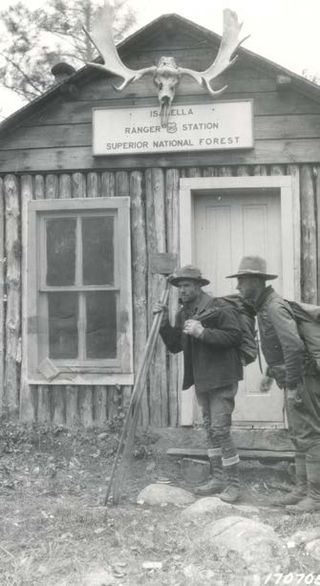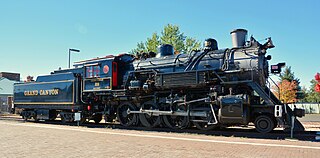
The Boundary Waters Canoe Area Wilderness is a 1,090,000-acre (4,400 km2) wilderness area within the Superior National Forest in the northeastern part of the US state of Minnesota under the administration of the U.S. Forest Service. A mixture of forests, glacial lakes, and streams, the BWCAW's preservation as a primitive wilderness began in the 1900s and culminated in the Boundary Waters Canoe Area Wilderness Act of 1978. It is a popular destination for canoeing, hiking, and fishing, and is one of the most visited wildernesses in the United States.

County State-Aid Highway 12 (CSAH 12), also known as the Gunflint Trail, or County Road 12 (CR 12), is a 57-mile (92 km) paved roadway and National Scenic Byway in Cook County, Minnesota, that begins in Grand Marais and ends at Saganaga Lake in the Boundary Waters Canoe Area Wilderness (BWCAW), near the U.S. border with Ontario. It provides access to many of the entry points in the BWCAW.

The North Shore of Lake Superior runs from Duluth, Minnesota, United States, at the western end of the lake, to Thunder Bay and Nipigon, Ontario, Canada, in the north, to Sault Ste. Marie, Ontario in the east. The shore is characterized by alternating rocky cliffs and cobblestone beaches, with forested hills and ridges through which scenic rivers and waterfalls descend as they flow to Lake Superior.

The Duluth, South Shore and Atlantic Railway (DSS&A) was an American railroad serving the Upper Peninsula of Michigan and the Lake Superior shoreline of Wisconsin. It provided service from Sault Ste. Marie, Michigan, and St. Ignace, Michigan, westward through Marquette, Michigan to Superior, Wisconsin, and Duluth, Minnesota. A branchline stretched northward from Nestoria, Michigan up to the Keweenaw Peninsula and terminating at Houghton, Michigan, with two branches extending further to Calumet, Michigan and Lake Linden, Michigan.
The Lake Superior and Ishpeming Railroad, is a U.S. railroad offering service from Marquette, Michigan, to nearby locations in Michigan's Upper Peninsula. It began operations in 1896. The LS&I continues to operate as an independent railroad from its headquarters in Marquette.
The Lake Superior and Mississippi Railroad is the name for two different railroads in Minnesota.

The GE 45-ton switcher is a 4-axle diesel locomotive built by General Electric between 1940 and 1956.
The Port Arthur, Duluth and Western Railway (PADW) was a Canadian railway that operated in Northwestern Ontario.

The Escanaba & Lake Superior Railroad is a Class III shortline railroad that operates 347 miles (558 km) of track in Northeastern Wisconsin and the Upper Peninsula of Michigan. Its main line runs 208 miles (335 km) from Rockland, Michigan, to Green Bay, Wisconsin, and it also owns various branch lines and out-of-service track. In 1897, the Escanaba River Company built a seven-mile (11 km) railroad from Wells, Michigan to tap a large hardwood timber stand at LaFave’s Hill. In 1898, the company name was changed to the Escanaba & Lake Superior Railway (E&LS).
The Rove Formation, is a sedimentary rock formation of Middle Precambrian age underlying the upper northeastern part of Cook County, Minnesota, United States, and extending into Ontario, Canada. It is the youngest of the many layers of sedimentary rocks which constitute the Animikie Group.

The Isabella Ranger Station is a complex of 21 buildings in Stony River Township, Minnesota, United States, near the town of Isabella. It is located on Minnesota State Highway 1 about one mile east of Isabella. The complex is listed on the National Register of Historic Places for its association with New Deal federal relief construction.
Brule Lake is a lake in Cook County, Minnesota. It is situated between two long sills in the Superior Upland, causing the lake to be eight times longer east and west than it is north and south. Out of the opposite ends flow the Temperance River and the South Brule, a tributary of the Brule River. Brule Lake was logged heavily in the early 1900s, and the region around it was consumed in 1929 by a logging-related forest fire which bears Brule Lake's name. Now the lake is part of the protected Boundary Waters Canoe Area, a federal wilderness area for which Brule Lake serves as an entrance point.

The Minnesota and International Railway was a subsidiary of the Northern Pacific Railway, a railway that operated in the western United States along the Canada–United States border. In 1970, the Northern Pacific merged with other lines to form the Burlington Northern Railroad.
Leeblain is a ghost town in the Canadian province of Ontario, located on the north shore of Gunflint Lake in the Thunder Bay District. Part of the ghost town is located within La Verendrye Provincial Park and is adjacent to the well known Boundary Waters Canoe Area Wilderness in the Boundary Waters between Canada and the United States.

Gooseberry River is a 23-mile stream in Lake County, Minnesota, USA, draining into Lake Superior. It is known for its waterfalls, near its mouth in Gooseberry Falls State Park. The Gooseberry, like many of its neighboring streams, has an irregular discharge highly dependent on runoff from rain and snow melt. The region around the river was heavily forested and much logging took place during the early 20th century. The forest has since regrown and the falls and mouth of the river are now a thriving tourist destination.

The Paulson Mine is a former iron ore mine located in Cook County, Minnesota, United States, 53 kilometres north-west of Grand Marais, Minnesota near the end of the historic Gunflint Trail. The Port Arthur, Duluth and Western Railway was built to the mine in 1892 to access the ore, but both the mine and railway failed.
Herman Finger was a lumberman who owned and operated various lumber companies that operated in Wisconsin, Minnesota, Ontario, Manitoba, and Saskatchewan. He also served as the first mayor of The Pas after its establishment in 1912.

Grand Canyon Railway No. 29 is the sole example of the class "SC-3" 2-8-0 "Consolidation" type steam locomotive. It was built by the American Locomotive Company (ALCO) in Pittsburgh, Pennsylvania in May 1906 for use in hauling carloads of iron ore on branch lines of the Lake Superior and Ishpeming Railroad as engine No. 14, and it was renumbered 29 in 1923. It was retired from revenue service in 1956. In 1963, it was sold to the Marquette and Huron Mountain Railroad, but it never ran there, and it was eventually sold to the Mid-Continent Railway Museum. Today, it resides at the Grand Canyon Railway as a running mate to former Chicago, Burlington and Quincy 2-8-2 No. 4960. As of 2022, though, it is going through a 1,472-day FRA boiler inspection.

Duluth and Northern Minnesota No. 14 is a preserved MK class 2-8-2 light "Mikado" built by the Baldwin Locomotive Works for the Duluth and Northern Minnesota Railroad in 1913. In 1919, the D&NM declared bankrupt, and the locomotive was sold to the Michigan-based Lake Superior and Ishpeming Railroad, to operate there as No. 22. It was renumbered back to 14 in 1923. In 1959, No. 14 was sold to the Inland Stone Division of Inland Steel Company, another Michigan-based corporation, and it operated there until 1966. In 1974, it was transferred to the Duluth, Missabe and Iron Range Railway, and then it was donated to the Lake Superior Railroad Museum in 1981. The locomotive was restored to operation for use on the museum's North Shore Scenic Railroad between 1992 and 1998. As of 2022, No. 14 remains on static display inside the museum in Duluth, Minnesota.












